Taxonomy: Class: Mammalia; Order: Artiodactyla; Family: Cervidae
Description
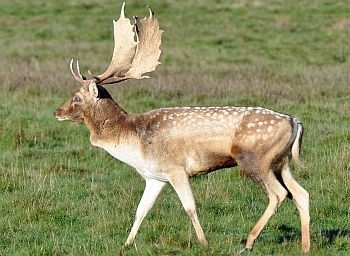
Fallow deer © Peter Thompson
The fallow deer went extinct in Britain during the last Ice Age, and was re-established by the Normans for hunting in the 11th century. Typically its coat is fawn with white spotting, but white varieties also occur, as do black ones. The male has palmate antlers cast in April-June. The fallow deer prefers mature broad-leaved or mixed woodlands. Bucks may be shot from 1 August to 30 April, does from 1 November to 31 March.
Further information:
Forestry Commission website .
Conservation status and legislation
Status:
UK: Native
World: Least Concern (IUCN Red List)
Legislation:
Distribution and abundance
The fallow deer is widespread across England and Wales, including Anglesey. In Scotland it occurs in isolated pockets, mainly in Perthshire and Stirlingshire, as well as on the islands of Islay, Mull, Lambay and Scarba. It also occurs across much of Ireland, although a scarcity of records means that this is not apparent from the map.
Estimates of fallow deer abundance (numbers of individuals in the spring) across the UK, from Harris et al. (1995):
Recent trends from the National Gamebag Census
United Kingdom
Index of bag density from 1976 to 2009 (see statistical methods and interpretational considerations).
Error bars represent 95% confidence intervals.
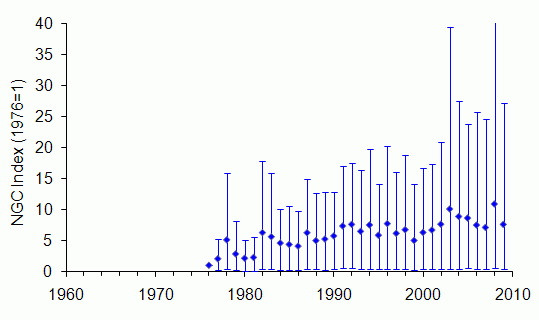
Too few sites provided records to evaluate trends before 1976. After a brief initial increase after 1976, the UK bag index has remained approximately stable between 1982 and 2009. The period of increase corresponded to a period of range expansion that slowed after the 1990s (see maps).
Change in fallow deer bags over time, with 95% confidence limits (see statistical methods):
| Country |
Sites |
Start
year |
End
year |
Change (%)
1961-2009 |
Change (%)
1984-2009 |
Change (%)
1995-2009 |
| United Kingdom |
150 |
1976 |
2009 |
370
-21 to 1051 |
84
-7 to 338 |
30
-23 to 141 |
* significant at P < 0.05
England
Index of bag density from 1976 to 2009 (see statistical methods and interpretational considerations).
Error bars represent 95% confidence intervals.
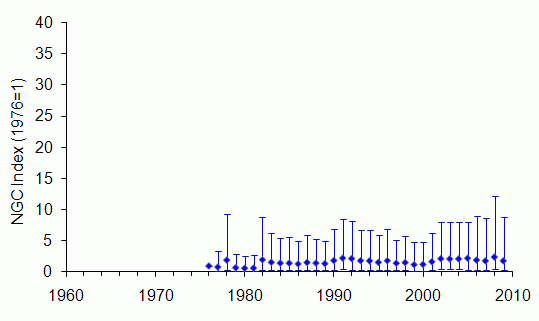
Too few sites provided records to evaluate trends before 1976. The bag index for England has remained approximately stable between 1976 and 2009., with perhaps a brief initial increase. Throughout this period there was an expansion in range (see maps).
Change in fallow deer bags over time, with 95% confidence limits (see statistical methods):
| Country |
Sites |
Start
year |
End
year |
Change (%)
1961-2009 |
Change (%)
1984-2009 |
Change (%)
1995-2009 |
| England |
127 |
1976 |
2009 |
107
-46 to 507 |
47
-14 to 303 |
21
-31 to 148 |
* significant at P < 0.05
Scotland
Index of bag density from 1976 to 2009 (see statistical methods and interpretational considerations).
Error bars represent 95% confidence intervals.
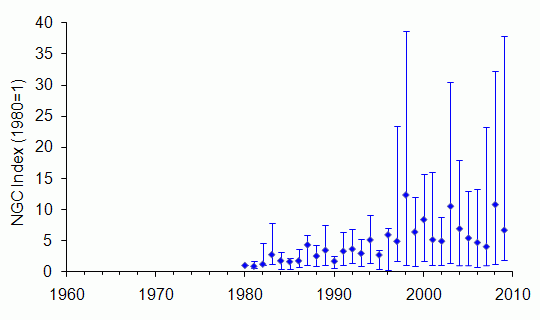
Just seven sites reported fallow deer in Scotland between 1961 and 1975. There has been a significant increase in the bag index from 1976 onwards following range expansion and increasing abundance (see maps).
Change in fallow deer bags over time, with 95% confidence limits (see statistical methods):
| Country |
Sites |
Start
year |
End
year |
Change (%)
1961-2009 |
Change (%)
1984-2009 |
Change (%)
1995-2009 |
| Scotland |
18 |
1976 |
2009 |
940*
502 to 3499 |
269
-15 to 1815 |
39*
3 to 787 |
* significant at P < 0.05
Wales
There are too few bag records of fallow deer to produce an index graph. 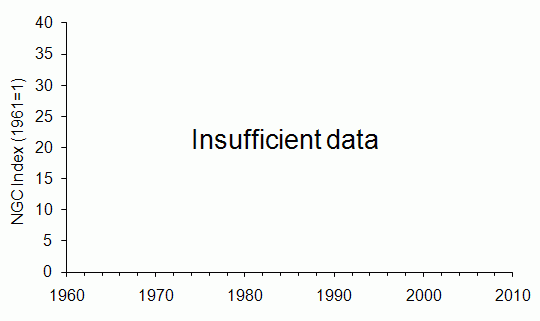
There are too few bag records of fallow deer to evaluate rates of change over time
| Country |
Sites |
Start
year |
End
year |
Change (%)
1961-2009 |
Change (%)
1984-2009 |
Change (%)
1995-2009 |
| Wales |
Too few sites |
N Ireland
There are too few bag records of fallow deer to produce an index graph. 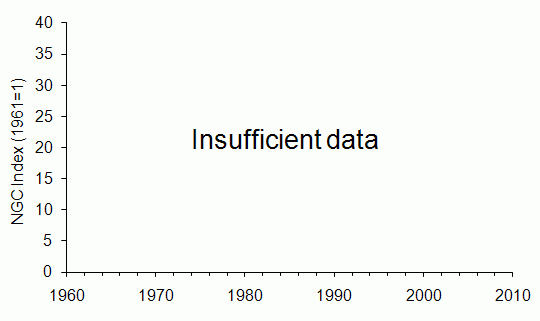
There are too few bag records of fallow deer to evaluate rates of change over time
| Country |
Sites |
Start
year |
End
year |
Change (%)
1961-2009 |
Change (%)
1984-2009 |
Change (%)
1995-2009 |
| N Ireland |
Too few sites |
Environmental zones
Change in fallow deer bags over time, with 95% confidence limits (see statistical methods):
| Environmental zone |
Sites |
Start
year |
End
year |
Change (%)
1961-2009 |
Change (%)
1984-2009 |
Change (%)
1995-2009 |
| Easterly lowlands (England/Wales) |
108 |
1976 |
2009 |
105
-45 to 623 |
48
-10 to 275 |
23
-32 to 141 |
| Westerly lowlands (England/Wales) |
15 |
1995 |
2009 |
no data |
no data |
20
-64 to 156 |
| Uplands (England/Wales) |
Too few sites |
| Lowlands (Scotland) |
Too few sites |
| Intermediate uplands/islands (Scotland) |
Too few sites |
| True uplands (Scotland) |
Too few sites |
* significant at P < 0.05
Comparison with BBS mammal data
Since 1995, data on fallow deer abundance have been collected under the Breeding Bird Survey (BBS) organised by the British Trust for Ornithology. Below, the UK trend from the NGC is compared to the one from the BBS (from 1995 onwards).
NGC index of bag density (blue) and BBS index of abundance (red), from 1995 to 2009.
Error bars represent 95% confidence intervals.
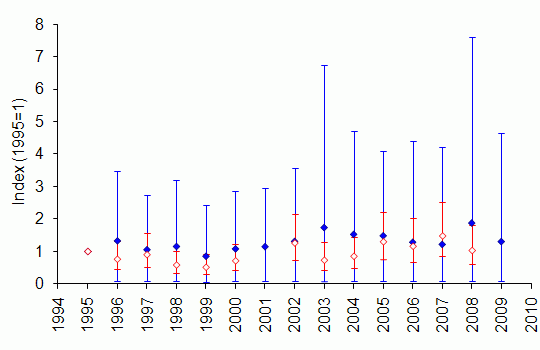
The BBS records are limited to England and show no significant change. For all years, the BBS confidence intervals are completely or almost completely within the NGC confidence intervals, indicating good agreement between the two index series.
Long-term trend from the National Gamebag Census
There are too few bag records of fallow deer to produce a trend starting before 1976.
References and further reading
- Battersby,J. (2005). UK Mammals: Species Status and Population Trends. Joint Nature Conservation Committee/Tracking Mammals Partnership, Peterborough (JNCC download page).
- Chapman,D. & Chapman,N.G. (1975). Fallow Deer: Their History, Distribution and Biology. Terence Dalton, Lavenham.
- Deer Initiative (2008). Species Ecology: Fallow Deer. England & Wales Best Practice Guides, The Deer Initiative, Chirk (PDF file - 4,918 KB).
- Harris,S., Morris,P., Wray,S. & Yalden,D.W. (1995). A Review of British Mammals: Population Estimates and Conservation Status of British Mammals Other than Cetaceans. Joint Nature Conservation Committee, Peterborough (JNCC download page).
- Harris,S. & Yalden,D.W. (2008). Mammals of the British Isles: Handbook, 4th edition. Mammal Society, Southampton.
- Langbein,J. & Chapman,N.G. (2002). Fallow Deer. Mammal Society & British Deer Society, Southampton & Fordingbridge.
This report should be cited as: Aebischer,N.J., Davey,P.D. & Kingdon,N.G. (2011). National Gamebag Census: Mammal Trends to 2009. Game & Wildlife Conservation Trust, Fordingbridge (http://www.gwct.org.uk/ngcmammals).
Return to species list